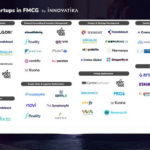
Anyone who manages a company often hears that success is not an accident, but the result of a solid strategic plan. In the context of business, strategy is not just a fashion word, but a key element that can determine success or failure. After a thorough internal and environmental analysis, we are ready to proceed to build a solid strategy that will lead our company to new heights.
From the article “Company strategy – how to develop it in a large organization?” you will learn how to start working on a strategy. In this text I will describe how we at Innovatika approach the next step, that is, defining the strategy.
Tim Berry, founder of Palo Alto Software, is the author of a statement with which I strongly identify. He stated, “Strategy is focus. Good strategy is deciding on opportunities that you choose not to pursue.” This statement is key to understanding what it really means to create a strategic plan. The key is saying “NO.”
Base components of the strategic plan
A strategic plan is not just an abstract concept. It consists of concrete elements such as mission, vision, goals, positioning and advantages in the business model. Mission is the essence of the company’s existence, vision is the dream of the future, goals are the specific milestones we want to achieve, and positioning and advantages are how we intend to compete in the market. We don’t operate in a vacuum, so we should treat our environment equally with our internal situation.
Build on strengths and eliminate weaknesses
If we already know what mission and vision we want to pursue and by what goals we will measure their achievement, we can proceed to defining our strategic plan. How to do it? Build a plan that reinforces the strengths and addresses the weaknesses of your organization.
Probably the best known method of business analysis (which, in my opinion, is also the one most often done without due diligence) is the SWOT (strengths, weaknesses, opportunities, threats) analysis. It allows us to identify areas where we can build our competitive advantage.
What is obvious is that it is worth knowing your true, and sometimes very deeply hidden, strengths. They are what make your organization work. Find out which elements of your business model show above-standard results that your competitors can only dream of. There you will find the most important pieces of your puzzle.
The signals for discovering key weaknesses are, of course, poor results in specific areas, the difficulty being that very often these results are the result of carefully hidden problems. What is seen in the foreground is not necessarily the cause at all, but the effect. Stubbornly digging to the core is the only way to properly identify challenges, and dealing with these challenges are opportunities to achieve spectacular improvements at the strategic level.
Seize business opportunities and build resilience against threats
The LoNGPESTEL model helps us look at opportunities (Local, National, Global capture of Political, Economic, Social, Technological, Ecological and Legal factors) and threats that we don’t necessarily have control over because they don’t depend on us or only on us. With this analysis, we can ensure that we build on our strengths and weaknesses uninterruptedly.
Changes in the environment are as certain as taxes and death. What is uncertain is their direction and strength. Sometimes they come suddenly, such as wars, pandemics or natural disasters, and sometimes they are obvious trends that are hard to miss, such as the global shift toward clean energy sources and changing social attitudes.
Your company operates in a specific environment, and it should be obvious to you that what will be a major threat to others may be a unique opportunity for you (look at the revenues of companies producing disposable masks and gloves during a pandemic on the one hand, and travel agencies on the other). How to deal with it? Don’t panic or get overly lucky. At the level of strategy, make sure you are flexible and can nimbly change plans. Spectacular opportunity and spectacular danger are bound to happen to your company. Don’t miss them. Don’t be like Kodak, don’t pretend you don’t see changes in your environment.
Verify strategic alternatives and choose your own path
It is important for your company to be ready for different scenarios. Defining strategic alternatives allows us to respond flexibly to changes in the environment and choose the best path to achieve our goals at any given time.
An infinite number of ideas arise during strategy development. The role of management is to hide 99% of them in a drawer. How to do it? First, write down these ideas, evaluate and arrange them into alternative or complementary clusters. Such a cluster should be based on a coherent narrative. They should be different enough from each other to allow comparison and hard business evaluation. The evaluation of clusters should be based on criteria that are firstly as objective as possible, and secondly are tailored to the situation of your company and the market.
There is no easy path here, and I personally believe that this is the most difficult point in strategy development. Done well, it makes the whole team get the wind in their sails and gain faith and conviction that everything is possible to achieve.
Is your company ready for the future?
Strategic analysis requires looking into the future. Do you have the right tools to anticipate and adapt to change?
Once you’ve chosen a cluster of strategic ideas and outlined a specific strategic narrative, it’s worth checking whether this particular plan is future-proof and will actually allow you to remain flexible. This will make it possible to catch potential weaknesses of this solution already at the stage of defining the strategy and remove them even before implementation. The trend map and future scenarios superimposed on your plan should form a coherent whole, if this is not the case then it is time to rethink the chosen strategic direction.
Do you have the ability to execute your strategy?
Developing a strategy is not just an analytical game. We need to consider whether we have or can get the necessary resources (whether personal or financial) to carry out our plans. We should maintain a certain balance in this step. On the one hand, our plans should be ambitious but, on the other hand, take into account checking whether our company can afford to achieve these goals. Too unambitious plans will make the motivation in the organization too low to achieve even the truncated goals.
Excel is a true friend of every strategist. In this step, focus on financial analysis to make sure the goals are realistic and financially feasible. Ordinarily, in the world, answer the question “does it add up?”.
Results over actions
If our strategic plan works at all levels, including financially, then we are left with one big and most difficult step… effectively implementing the new strategy and achieving the goals set in it.
In the next article you will learn how to effectively implement a new strategy in a company. I invite you to continue reading, as we are about to embark on a fascinating journey into the world of strategic thinking and actions that can change the fate of any business.
Every company is different, so it is important to match the tools and methods of strategy building to the individual needs and characteristics of the company. If you would like to talk to us about your challenges, we invite you to contact us and schedule a free consultation with Jerzy Kurgan, Managing Director of Innovatika, who has many years of experience in co-creating and implementing strategic plans for large and medium-sized organizations. To schedule a consultation click here.







